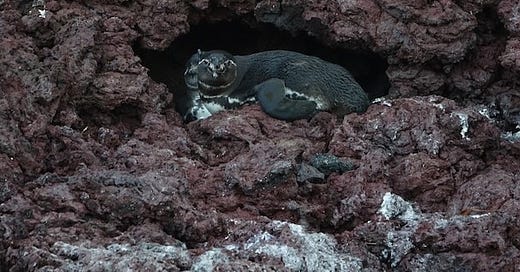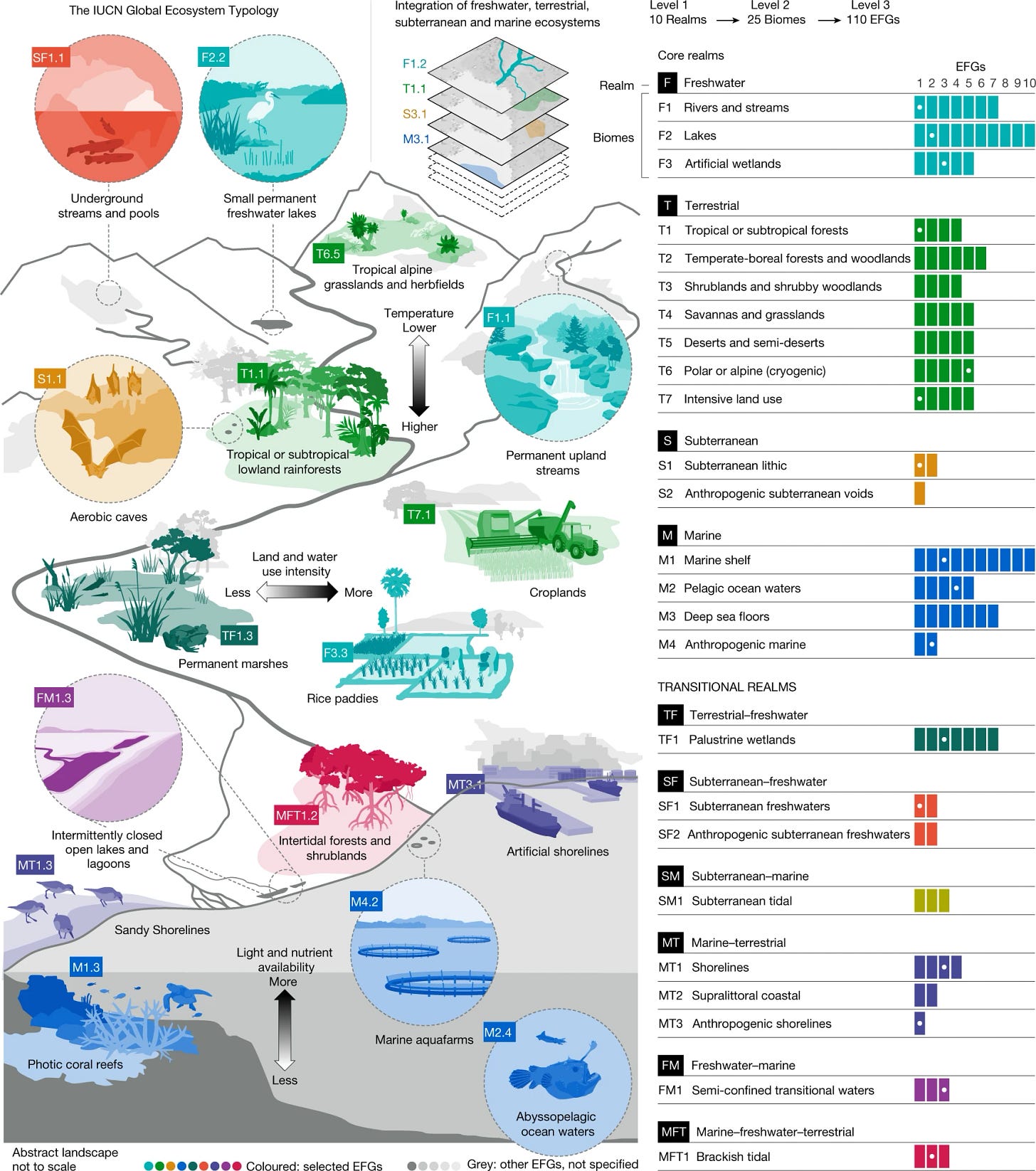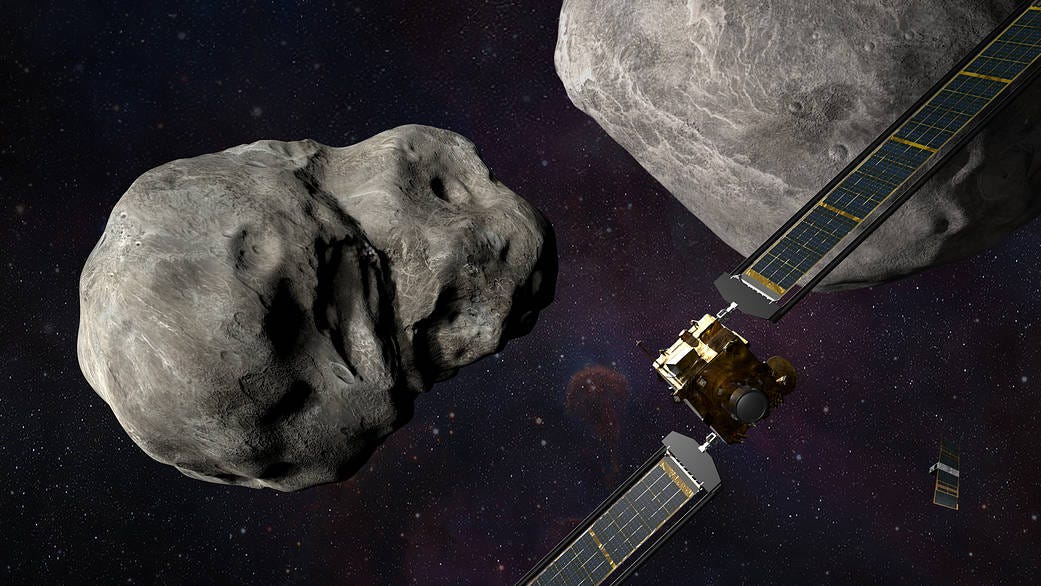The Weekly Anthropocene, October 19 2022
A Dispatch from the Wild, Weird World of Humanity and its Biosphere
The Galápagos Islands
Galápagos penguins (Spheniscus mendiculus) have had a rough Anthropocene so far. A particularly strong El Niño event in 1982 sent their population plunging from around 10,000 to less than 5,000, as warm waters killed off the local base-of-the-food-chain algae species, leading to starving fish, and then starving penguins. Cats and rats introduced by historic sailors are still taking a toll on nests and eggs. And climate change and commercial fishing1 continue to depress local fish populations. There are only around 1,200 mature individuals now: the species is endangered. And Galápagos penguins don’t do well in captivity2, so there’s no captive breeding effort or backup population in zoos. However, one innovative, proactive conservation effort seems to be bearing fruit.
Galapagos penguins normally nest in their rocky islands’ lava tubes, offering shade for their chicks along with easy access to the sea. However, there are only so many lava tubes to go around. In 2010, penguin conservationist Dr. P. Dee Boersma and her team used crowbars and hammers to chisel out 120 new nesting sites into the lava of several islands that were relatively unaffected by cats and rats. The penguins took advantage of the extra breeding space immediately: since then, nearly a quarter of all observed breeding activity has been in the constructed nests, up to 43% in some years on Mariela Island. Today, 84 of the 120 nests are still usable, and though the population remains small, a new census found that about 25% of living Galapagos penguins are juveniles, a hopeful sign of successful breeding indicating that the species could yet rebound in the future if all goes well. Here’s hoping these unique tropical penguins receive all the support and protection they need!
Spain
Spain is absolutely zooming forward in the transition to clean, renewable energy. Wind energy has risen from providing less than 2.5% of Spain’s electricity in 2000 to over 22% now, while solar has advanced even more sharply from less than 0.01% in 2000 to nearly 10% in 2021 (see chart above and percentages source)3. Furthermore, factoring in the contributions of nuclear and hydropower brought enough low-carbon electricity to meet over 64% of Spain's electricity needs in 2021, and it’s, with progress ramping up sharply this year.
2022 saw the opening of the largest solar plant in Europe (pictured) in Extremadura, Spain, a 590-megawatt capacity facility providing clean energy to 344,000 Spanish homes, and many more are on the way. Spain’s record-high renewables generation in 2022 has already led to an avoided 1.7 billion euros of imported gas costs, a key factor as Europe stands against Russian aggression. 2022 also saw a massive boom in Spain’s rooftop solar, with Spanish Environmental Transition Minister Teresa Ribera stating that rooftop solar installations have increased tenfold so far this year. These are all great that Spain is on track to meet its official target of 74% renewable electricity generation by 2030 and 100% by 2050!
Furthermore, a new federal law passed in 2021 mandates that all Spanish cities with a population over 50,000 (or above 20,000 if there’s particularly bad pollution) must create low-emission zones within their borders, limiting access to old-style fossil fuel-burning cars. That’s almost 150 cities now planning to create low-emission zones in 2023! And some cities are already running with the idea: Barcelona is set to ban all fossil fuel-burning cars within city limits.
Spain is a great example of how a developed, high-living-standards economy can, with just a little investment and regulatory support, unleash a vast surge of clean energy progress. Great news!
Global Ecosystems
After a unified worldwide research effort, the International Union for Conservation of Nature (IUCN) has developed the first-ever Global Ecosystem Typology, a “canonical” classification for all of Earth’s ecosystems. Check out the full paper in Nature, the example diagram above, and the website. The new typology categorizes all of Earth’s life-bearing territory, land, water, ice, and underground, into a comprehensive three-tiered system of 10 Realms, 25 Biomes, and 110 Ecosystem Functional Groups. Notably, it includes human-created ecosystems like rice paddies and marine aquaculture as well, critical for ensuring that the typology matches the real-world conditions of Anthropocene Earth. Fascinating news!
Didymos and Dimorphos
Okay, this story is pretty far outside The Weekly Anthropocene’s normal focus on Earth’s biosphere, but it’s just so cool, it absolutely had to be written about. On September 26, 2022, NASA’s Double Asteroid Redirection Test (DART) probe intentionally crashed into Dimorphos, the tiny moon of the mountain-sized asteroid Didymos, in humanity’s first time ever changing of motion of a natural celestial object. (Pictured: artist’s impression). It succeeded well beyond expectations, shortening Dimorphos’ orbital period by 32 minutes when the designated “success” threshold was 73 seconds, which in turn slightly affected the trajectory of Didymos. While these asteroids weren’t a threat, the explicit purpose of this mission was to practice “planetary defense” asteroid deflection techniques, and its success is good news for everything living on Earth.
“All of us have a responsibility to protect our home planet. After all, it’s the only one we have. This mission shows that NASA is trying to be ready for whatever the universe throws at us. NASA has proven we are serious as a defender of the planet. This is a watershed moment for planetary defense and all of humanity, demonstrating commitment from NASA's exceptional team and partners from around the world.”-NASA Administrator Bill Nelson.
Planetary defense is a surprisingly well-supported field: much more asteroid deflection research is planned after this successful proof of concept, and we already have a robust range of near-earth asteroid detection projects scanning for potential threats (with a new specialized space telescope in the offing as well). It seems like there’s now a pretty good chance that if a “dinosaur-killing” near-Earth asteroid came along these days, humanity could spot it and send a probe to nudge it onto a different path well before it became a threat to our favorite blue marble. Great news!
Even though the islands and their waters are legally protected by Ecuador’s government as the Galápagos Marine Reserve, giant “pirate fishing fleets” remain a problem. For example, in 2021 a flotilla of almost 300 floating slaughterhouses from China spent months lurking just outside the international boundary, hoovering up thousands of tonnes of fish and squid heading into and out of the park and probably poaching in Ecuadorian territory as well. China operates a massive high seas fishing fleet that operates around the globe, often sitting just outside the waters of poor, developing countries and scooping up vast quantities of fish (as in West Africa). These “devil vessels” are widely known for both their disregard of environmental protection treaties and their abhorrent abuse of workers, often amounting to debt slavery.
Sometimes a species just won’t stay alive in captivity, even when closely related species are fine, and scientists aren’t exactly sure why. For example, as discussed in a previous newsletter, cheetahs almost always contract a wide range of mysterious diseases as soon as you put them in zoos, while other big cats are commonly captive bred. In these cases, protection of free-living populations becomes paramount, as there’s no possible safety net in the case of extinction in the wild.
A great new analysis found that clean energy technologies tend to grow extremely rapidly once they pass a “tipping point” of 5% of a country’s market, and that certainly seems to be the case here.








